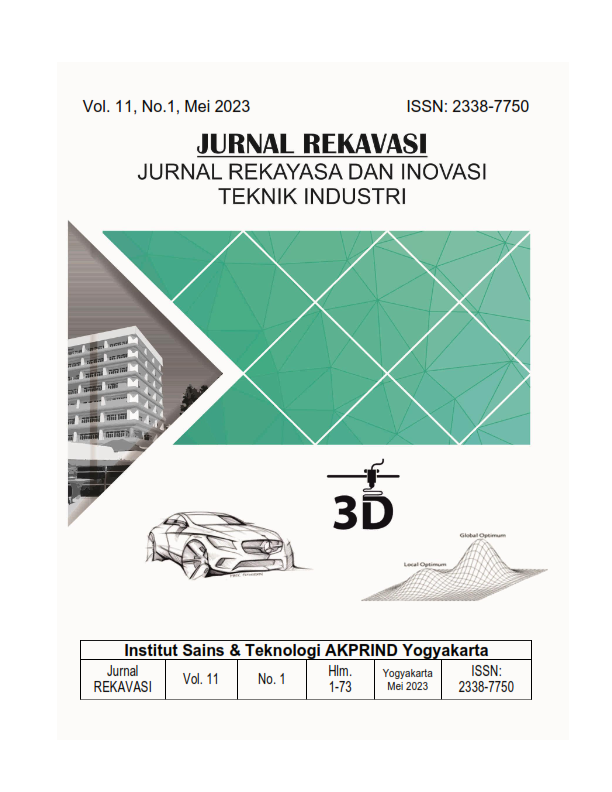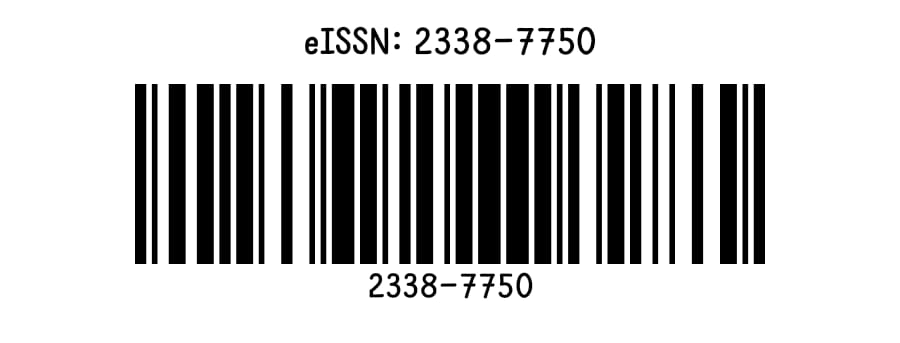PENGENDALIAN KUALITAS KAIN KATUN MENGGUNAKAN METODE STATISTICAL QUALITY CONTROL DAN KAIZEN SEBAGAI UPAYA MENGURANGI PRODUK CACAT (Studi Kasus: PT. Kusuma Mulia Plasindo Infitex)
DOI:
https://doi.org/10.34151/rekavasi.v11i1.4361Keywords:
Cotton Fabric, Quality Control, Statistical Quality Control, KaizenAbstract
- Kusuma Mulia Plasindo Infitex is a company engaged in producing cotton fabric as its superior product. With the increasing demand for cotton fabrics, this does not necessarily guarantee in full that the resulting product is free from defects or damage. Based on preliminary observations, especially in the part of the cotton fabric production process, it was found that the product was not feasible or did not meet the standard as much as 9% of the average production a day, namely 10. 000 meters. Meanwhile, the tolerance standard applied by the company is 5%. The purpose of this study is to identify dominant defective products, identify the causes of defective products, know the limits of product quality control in the inspection section and propose improvement plans based on statistical quality control and kaizen methods. Based on the results of statistical quality control on the pareto diagram, it is seen that the most dominant defect is loose feed as
13.178 meters with a defect percentage of 49.24% produced during the 31-day observation. After observing the occurrence of defects in cotton fabrics, there are five factors, namely humans, environment, methods, materials, and machines. On the control map p, there are ten data points that are outside the upper control limit, namely at points 3,4,5,9,17,23,27,29,30, and 31. Then there are eight points that are outside the lower control limit, namely at points 7,12,13,14,18,19,25 , and 26 so it is said that the condition of the cotton fabric production process for 31 days from March 1 to March 1, 2021 has not been controlled so it is necessary to find factors causing defects that are beyond the limits of lower and upper control using fishbone diagrams. Improvements are made to the dominant defects and causes of disability by carrying out countermeasures or follow-up plans using the kaizen five M Checklist, 5W+1H and Five Step Plan methods
References
Adyatama, A, & Handayani, U.N., (2018). “Perbaikan Kualitas Menggunakan Prinsip Kaizen Dan 5 Why Analysis”, Jurnal Teknik Industri. 13(3):169-179.
Ahyari, A., (2004). Manajemen Produksi: Pengendalian Produksi, Edisi Ke-5, BPFE, Yogyakarta. Assauri, S., (2004). “Manajemen Produksi dan Operasi Edisi Revisi”, Lembaga Penerbit Fakultas
Ekonomi Universitas Indonesia, Jakarta.
Andiwibowo, R.R., Susetyo, J., & Wisnubroto, P., (2018). “Pengendalian Kualitas Produk Kayu Lapis Menggunakan Metode Six Sigma dan Kaizen Serta Statistical Quality Control Sebagai Usaha Mengurangi Produk Cacat”. Jurnal Rekavasi, Yogyakarta, Volume 6, Nomor 2, 100- 110.
Bakhtiar S., Suharto T., & Ria A., (2013). “Analisa Pengendalian Kualitas dengan Menggunakan Metode Statistical Quality Control (SQC)” (Studi kasus: pada UD. Mestika Tapaktuan). Jurnal Teknik Industri. 8(1):41-48.
Idris, I., Sari, R.A., Wulandari., & Uthumporn., (2016). “Pengendalian Kualitas Tempe Dengan Metode Seven Tools”. Jurnal Teknovasi, Politeknik LP3I Medan. 3(1):66-80.
Irwan & Haryono, D. (2015). “Pengendalian Kualitas Statistik: Pendekatan Teoritis dan Aplikatif, Alfabeta”, Bandung.
Kotler & Keller., (2009). “Manajemen Pemasaran 1, Edisi ketigabelas”, Jakarta: Erlangga. Kurniadi, R., (2020). “Analisis Pengendalian Kualitas Kain Katun Untuk Mengurangi Jumlah
Produk Cacat Dengan Menggunakan Metode Seven Tools dan Kaizen”. Skripsi. Fakultas Teknologi Industri. Jurusan Teknik Industri. IST AKPRIND. Yogyakarta.
Mursyidi., (2008). “Akuntansi Biaya Edisi Ke-5”, YKPN, Yogyakarta.
Nina, H., Raden, H., & Eva, L., (2019). “Analisis Statistical Quality Control (SQC) Pada Produk Roti di Aremania Bakery”. Jurnal Teknologi dan Manajemen Agroindustri. 8(1):41-48.
Refangga, M.A., Musmedi, P.D., & Gusminto, B.E., (2018). “Analisis Pengendalian Kualitas Produk Air Minum Dalam Kemasan Dengan Menggunakan Statistical Process Control dan Kaizen”, Jurnal Ekonomi Bisnis dan Akuntansi. (2):164-171.
Soesilo, R., (2017). “Implementasi Kaizen dan 5S Pada Pengeringan Produk di Proses Plating”, Jurnal Teknik Industri, Jakarta. 18(2):121-126.
Wijaya, T., (2011). “Manajemen Kualitas Jasa, Cetakan Ke-1”, PT. Indeks, Kembangan-Jakarta Barat.










